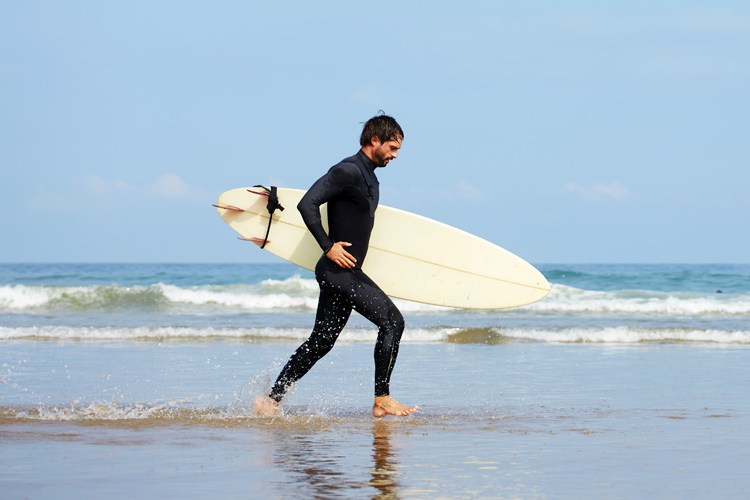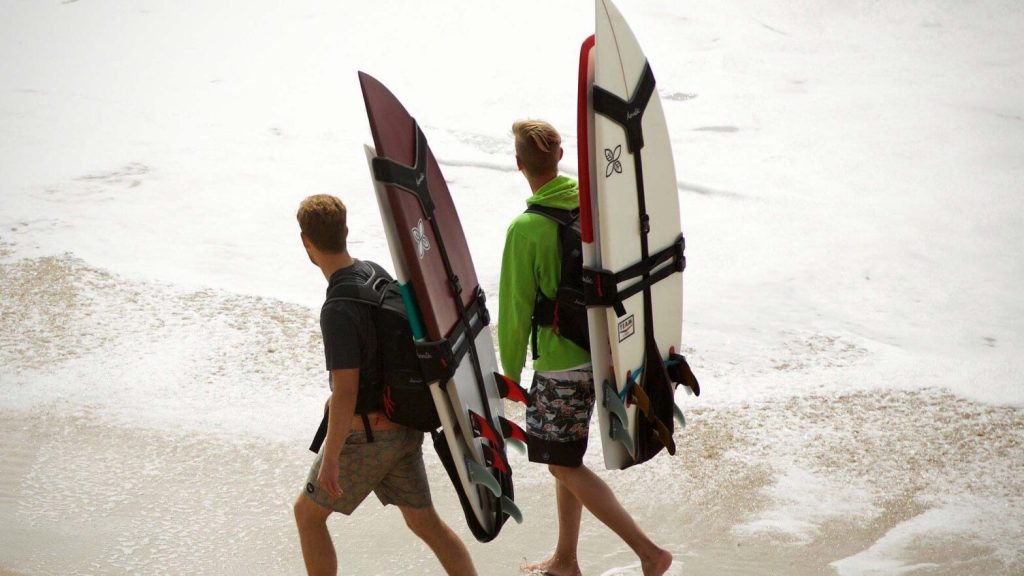Surfing is a thrilling and popular water sport that requires proper handling and care for the surfboard, both in and out of the water. Carrying a surfboard correctly is essential to prevent damage to the board and ensure it remains in optimal condition for years of enjoyable surf sessions.
Knowing how to carry a surfboard properly is fundamental whether you’re a beginner or an experienced surfer. In this article, we will provide tips and techniques on how to carry a surfboard and protect it from potential damage safely.
How to carry a surfboard

Carrying a surfboard requires careful handling to avoid damage to the board and ensure your safety. Here are some general steps to carry a surfboard safely:
- Choose an appropriate location: Find a flat, open space with enough room to maneuver without obstacles. Ensure the area is clear of sharp objects or debris that could damage the board.
- Stand the board upright: Hold the board by the rails (sides) with one hand towards the middle of the board and the other hand towards the tail. Stand the board upright on its tail, with the nose pointing upwards. Keep your fingers away from the fins to avoid injury.
- Use proper grip: Place one hand on the rail (side) of the board towards the middle and the other towards the tail. Avoid gripping the board too tightly, as it can cause strain on your arm and shoulder muscles.
- Carry the board on your side: Lift the board off the ground and rest it on your side, with the bottom of the board facing outward. Use your arm and shoulder to support the board’s weight, and walk with smooth and controlled movements.
- Be mindful of your surroundings: Remember your surroundings and avoid bumping into objects or people while carrying the surfboard. Also, be cautious of the fins and other protruding parts of the board to prevent accidental injuries.
- Avoid dragging the board: Dragging the surfboard on the ground can cause damage to the fins and the bottom surface of the board. Instead, always carry the board off the ground to prevent unnecessary wear and tear.
- Use a board bag or cover: If you have one, place the surfboard inside before carrying it. This provides extra protection for the board and makes it easier to carry.
- Seek assistance if needed: If the surfboard is too heavy or cumbersome for you to carry alone, seek assistance from a friend or another person to help you carry it safely.
Here are a few more tips for carrying a surfboard:
- Avoid extreme temperatures: Exposure to extreme temperatures, such as leaving your surfboard in direct sunlight for prolonged periods or storing it in a hot car, can cause damage to the board’s materials, including delamination or warping. Therefore, avoid carrying the surfboard in extreme temperatures to prevent potential damage.
- Use a board sock or protective cover: A board sock or a protective cover can provide additional protection for your surfboard while carrying it. These covers are designed to fit over the board and provide cushioning and protection against scratches, dings, and UV rays.
- Check for proper fin placement: Ensure the fins are correctly installed and secured before lifting and carrying the surfboard. Loose or misaligned fins can cause damage to the fins or the board while carrying, so double-check their placement before lifting the board.
- Avoid placing the board on hard surfaces: When setting the surfboard down, avoid placing it on hard or abrasive surfaces, such as rocks, asphalt, or concrete, as it can cause scratches or dings on the board. Instead, to gently place the board down, look for a soft, sandy, or grassy area.
- Follow local regulations: Some beaches or surf spots may have specific rules or regulations regarding surfboard transportation. Make sure to familiarize yourself with any local guidelines or restrictions and follow them accordingly to comply with the rules and protect the environment.
- Consider using a surfboard-carrying device: If you frequently carry your surfboard over long distances or need to transport multiple boards, you may consider using a surfboard-carrying device, such as a surfboard backpack, trolley, or rack. These specialized tools can make carrying surfboards more convenient and comfortable while also protecting the boards from potential damage.
Remember, taking care of your surfboard is essential to ensure its longevity and performance. Following these additional tips, you can protect your surfboard while carrying it and enjoy many memorable surf sessions with your beloved board.
Conclusion

Carrying a surfboard correctly is an essential skill for any surfer. Following the tips and techniques in this article, you can ensure that your surfboard remains in good condition and is ready for your next surf session. Remember to be mindful of the fins, use proper lifting techniques, be aware of wind conditions, avoid extreme temperatures, use protective covers, and follow local regulations.
Taking care of your surfboard is crucial for its longevity and performance, allowing you to enjoy and ride the waves confidently. So, next time you head to the beach, use these tips to carry your surfboard safely and keep it in top shape for your next surfing adventure. Happy surfing!



